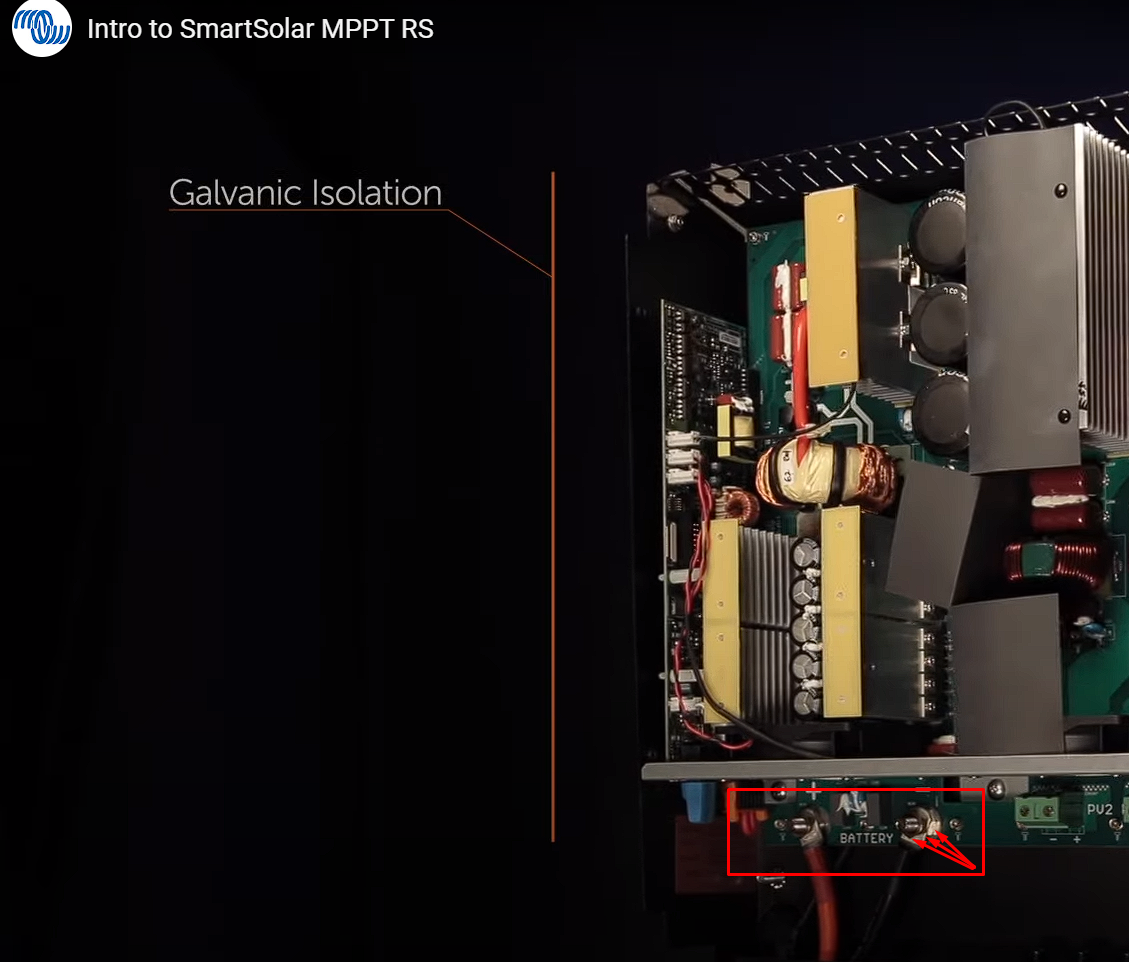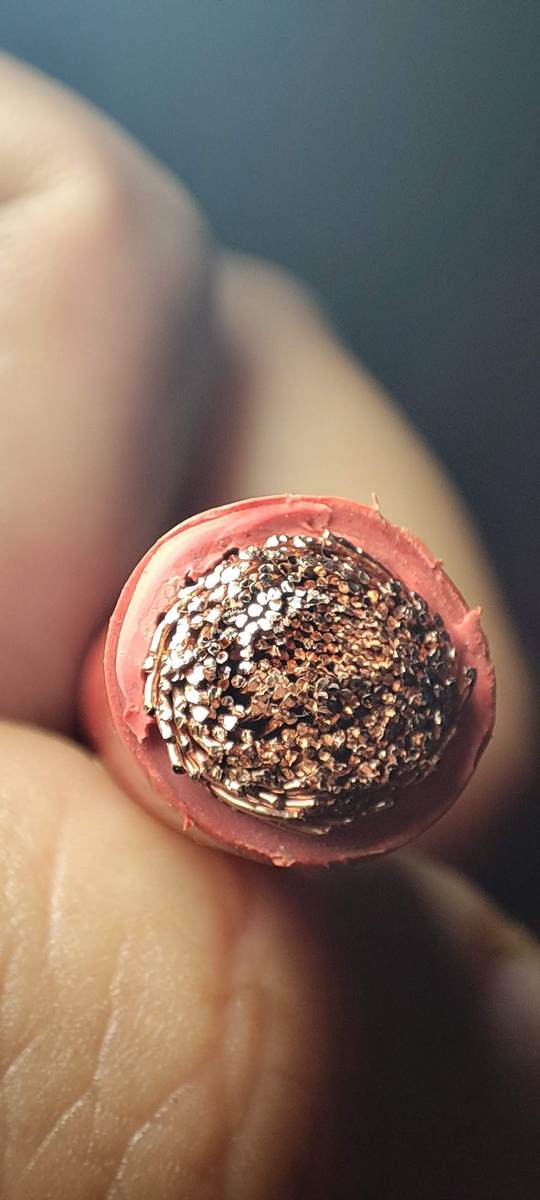I didn't see anything in the manual that mentions ferrules (although the manual does have a graphic that might indicate ferrules if those yellow ends of the wire are an indication), and opinions online seem to be all over the place. Right now I'm leaning toward not using ferrules because it's 7-strand PV wire, but I really have no idea. I have the ferrules and the tool, just don't know whether it's best practice in this case to put ferrules on or not. Many thanks for any thoughts!
- Home
- Anonymous
- Sign in
- Create
- Spaces
- Grafana
- Node-Red
- Unsupported topics
- Questions & Answers
- Modifications
- Communauté francophone
- Deutschsprachiger Bereich
- Preguntas en Español
- Explore
- Topics
- Questions
- Ideas
- Articles
- Badges
question
Ferrule or not? 10 AWG, 7-strand, PV wire into MPPT RS 450/200
I wouldnt use 7 strand cable.
https://www.victronenergy.com/media/pg/SmartSolar_MPPT_RS/en/safety-instructions.html
Oh great. We ordered 2800' of this stuff and had it shipped to Alaska. It wasn't cheap. Had no idea that there would be any issue with 600V rated direct burial PV wire.
If the reasoning is the "contact area" as the manual appears to suggest, then wouldn't this solution work?
I would think that this MIGHT just transfer the issue to MC4, but if the wire is specified as compatible with an MC4 connector, then yes, 7 strand solar to MC4 and then MC4 with fine strand to MPPT would be a solution.
Sounds like this will be my approach then. Use the CB to transfer over to the approved wire for the charge controller for the positive wire, then MC4 to transition for the negative wire.
@AlaskanNoob are you going to have a PV breaker next to the mppt?
Seems like an obvious place to switch wire types.
Make sure that the breaker's clamps can be used with your 7 strand cable.
But it's a single pole, so it would just be the positive wire going through it. So I'm still going to need to figure out how to get the negative to switch over before going into the MPPT (I think) so I will explore MC4 connections to make that transition.
Plus an MC4 for 8 AWG wire perhaps will help me find some wire that has the number of strands required, so far the largest number of strands I've found for 10 AWG is only 19 strands.
But it's a single pole, so it would just be the positive wire going through it.
That's kind of dangerous.
Imagine your + PV cable gets damaged and is leaking to earth. Now your - PV cable is - 450v in reference to earth. That's quite a spark should you disconnect the - cable from the mppt. Quite a heart stopper should you touch the - cable.
UPDATED POST - This post used to provide a definitive advice not to use ferrules with Victron MPPTs.
I would now recommend reading the discussion here for more up to date information and some nuance - https://community.victronenergy.com/t/using-ferules-pros-and-cons/1301
There is a concise instruction on when and how to use ferrules in Victron's Wiring Unlimited Guide - Electrical Connection chapter 10
Thank you so much for this clarification. It's great to get it from Victron rather than dueling opinions elsewhere on the internet!
Ferrules make for a much neater installation, but they limit the contact surface area.
In some cases this isn’t an issue, but in others it can be.
A square crimpted ferrule will be better than a loose round one over thick stranded cable, but all will be inferior to fine stranded cable inserted with care and then torqued correctly.
Failure of an MPPT due to insufficient contact at the terminals is all too common unfortunately, though many MPPTs are also installed without optimum contact and without issues as well.
Best practice is a clean job, with fine strand to spec, and maximum contact surface area.
Would love to see these resources when you make them, especially if they show how to insert the cables correctly and any ways to measure or confirm it's been done correctly. If the resistance is the issue, it would be great to measure that if possible for peace of mind. We'll have 8 trackers getting 400V or so, in the middle of a large forest, and there is no fire department so anything you can make to help us get this right would be greatly appreciated!
Also, I had read that fine thread wire going into the terminals was more likely to have a thread break off and cause problems which makes sense so I suppose that is part of why you mentioned inserting with care. If there is any way to tell/confirm that inserts were done properly and no threads were broken that would be great. I suppose a way of securing the wires so they don't get tugged after the install and brad a thread might also be in order?
Wiring should always be mechanically supported so there is no stress on electrical connections. That should not be debated.
The ferrules issue often is but with the rising clamp design and the use of fine strand it is not necessary on the Victron equipment.
We ordered this 10 AWG PV wire that should meet the strand specs (87 strand) for use with the MPPT RS:
https://bulkwire.com/solar-pv-wire-600v-ul-4703
We’ve been digging into this issue a bit on the diy solar forum. Maybe a sliding gate grip does better without a ferrule. But the documentation and guidance on what wire treatment is appropriate under what circumstances is lacking in the product specific Victron documentation. Surprising for Victron to fall down on this important detail.
Any chance for some formal guidance to include a consult with the engineering staff?
See: https://diysolarforum.com/threads/source-to-buy-quality-wire-ferrules.60670/">https://diysolarforum.com/threads/source-to-buy-quality-wire-ferrules.60670/
Strange that victron say : do not use ferrule but a multi strand wire to maximise contact while their battery connector is....so...badly done on the rs450, the lug is supposed to be put over a nut....with near no surface contact.
Explain this rs450 double nuts situation...why the hell there is a nut there while the lug should contact with the maximum surface and the nut preventing this to happend...? I've read the documentation and no clue on how to use those 2 nuts, I removed both and put lugs in contact with the electronic board.
As can be seen in the datasheet as well as the introduction video of the RS line, the bottom nut is intended to stay in place, the lug is placed on top of that, followed by the washer, the lock washer, and the final nut.
The bottom nut serves two purposes: it allows you to use an open box wrench underneath the lug so that you can put counterpressure on the assembly to ensure that you can properly torque the top nut without causing undue stress to the PCB, and it provides an airgap to allow for heat dissipation in the assembly.
This type of connection setup is not at all uncommon in high-voltage high-current applications, and so long as the lug size is appropriate to the stud size, there is no appreciable decline in surface area contact because not only the nut but in fact the entire stud is carrying the current.

Hello,
That would be the other option, but in this case why the MPII do not have this configuration (2 nuts), why only the RS450 ?
A M8 is 8mm => Roughly 50mm2 surface but stainless steel have a 5x resistance vs Cu.... so why wanted to go through all those contact surfaces : Lug > Nut > Bolt > Board contact. There is no contact between the bolt and the lug.. near none.
There is something really not obvious here. But yes i agree that the mecanical resistance is better ...
About strands, i'm using regular 35mm2 cable,do not know how many there are... here is my 50mm2.

e
@AlaskanNoob I think Wiring Unlimited says somewhere that fine stranded wire (they give an exact count which is not 7) is to be used for Victron and specifically says that don't use wire with a few strands.
Fideri
I know the MPPT RS manual says to use many stranded PV cable. We ended up buying new cable with far more strands and we used that to connect our panels.
Hi, @AlaskanNoob
Class 5 or higher stranding according to VDE 0295, IEC 60228 and BS6360.
Your cable is Class 2.
Although, depending on you panel configuration and current that passes through circuits, lower number of strands could be OK, as long as you provide a very good surface contact by properly crimping the wires together.
question details
39 People are following this question.
